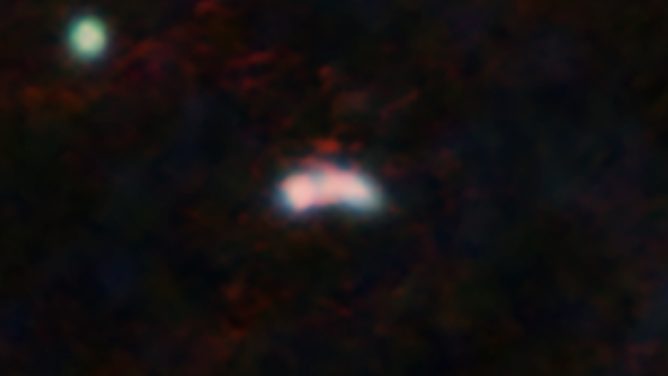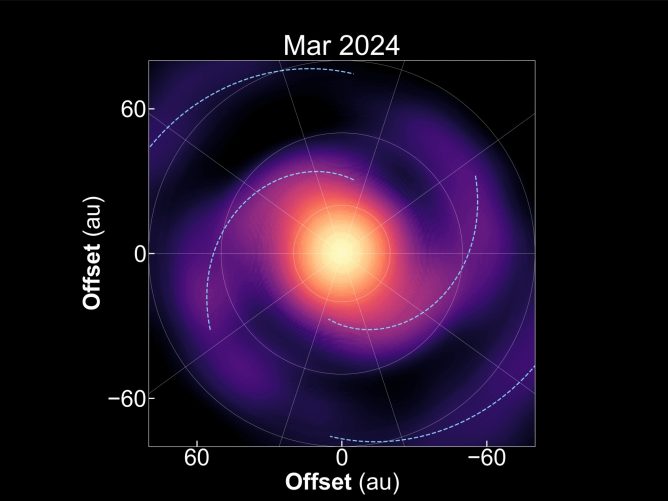An international team of astronomers using the Atacama Large Millimeter/submillimeter Array (ALMA) has witnessed a never-before-seen cosmic weather event—a cluster of towering intergalactic gas clouds raining in on the supermassive black hole at the center of an elliptical galaxy one billion light-years from Earth.
The new ALMA observations are the first direct evidence that cold dense clouds can coalesce out of hot intergalactic gas and plunge into the heart of a galaxy to feed its central supermassive black hole. They also reshape astronomers’ views on how supermassive black holes feed through a process known as accretion.
Previously, astronomers believed that, in the largest galaxies, supermassive black holes fed on a slow and steady diet of hot ionized gas from the galaxy’s halo. The new ALMA observations show that, when the intergalactic weather conditions are right, black holes can also gorge on a clumpy, chaotic downpour of giant, very cold clouds of molecular gas.
“This so-called cold, chaotic accretion has been a major theoretical prediction in recent years, but this is one of the first unambiguous pieces of observational evidence for a chaotic, cold ‘rain’ feeding a supermassive black hole,” said Grant Tremblay, an astronomer with Yale University in New Haven, Connecticut, and lead author on a paper appearing in the journal Nature. “It’s exciting to think we might actually be observing this galaxy-spanning ‘rainstorm’ feeding a black hole whose mass is about 300 million times that of our Sun.”
Tremblay and his team used ALMA to peer into a phenomenally bright cluster of about 50 galaxies, collectively known as Abell 2597. At its core is a singular massive elliptical galaxy, pragmatically dubbed the Abell 2597 Brightest Cluster Galaxy. Suffusing the space between these galaxies is a diffuse atmosphere of hot, ionized plasma, which was previously observed with NASA’s Chandra X-ray Observatory.
“This very, very hot gas can quickly cool, condense, and precipitate in much the same way that warm, humid air in Earth’s atmosphere can spawn rain clouds and precipitation,” Tremblay said. “The newly condensed clouds then rain in on the galaxy, fueling star formation and feeding its supermassive black hole.”

The cosmic weather report, as illustrated in this artist concept, calls for condensing clouds of cold molecular gas around the Abell 2597 Brightest Cluster Galaxy. The clouds condense out of the hot, ionized gas that suffuses the space between the galaxies in this cluster. New ALMA data show that these clouds are raining in on the galaxy, plunging toward the supermassive black hole at its center.
Credit: NRAO/AUI/NSF; D. Berry / SkyWorks; ALMA (ESO/NAOJ/NRAO)
Near the center of this galaxy, the researchers discovered this exact scenario: three massive clumps of cold gas careening toward the supermassive black hole in the galaxy’s core at 300 kilometers per second (roughly 670,000 miles per hour). Each cloud contains as much material as a million Suns and is tens of light-years across.
Normally, objects on that scale would be difficult to distinguish at these cosmic distances, even with ALMA’s amazing resolution.
They were revealed, however, by the billion light-year-long “shadows” they cast toward Earth. These shadows, known as absorption features, were formed by the in-falling gas clouds blocking out a portion of the bright background millimeter-wavelength light, which is emitted by electrons spiraling around magnetic fields very near the central supermassive black hole.
Additional data from the National Science Foundation’s Very Long Baseline Array indicate that the gas clouds observed by ALMA are approximately 300 light-years from the central black hole, essentially teetering on the edge of being devoured, in astronomical terms.

Composite image of Abell 2597 Brightest Cluster Galaxy.
The background image (blue) is from the Hubble Space Telescope. The foreground (red) is ALMA data showing the distribution of carbon monoxide gas in and around the galaxy. The pull-out box is the ALMA data of the “shadow” (black) produced by absorption of the millimeter-wavelength light emitted by electrons whizzing around powerful magnetic fields generated by the galaxy’s supermassive black hole. The shadow indicates that cold clouds of molecular gas are raining in on the black hole.
Credit: B. Saxton (NRAO/AUI/NSF); G. Tremblay et al.; NASA/ESA Hubble; ALMA (ESO/NAOJ/NRAO)
While ALMA was only able to detect three of these clouds, the astronomers speculate there may be thousands like them.
The astronomers now plan to use ALMA in a broader search for these “rainstorms” in other galaxies to determine if such cosmic weather is as common as current theory suggests it to be.
Reference:
“Observational evidence for cold, clumpy accretion onto an active supermassive black hole,” Grant Tremblay et al., 2016, Nature.
The team is composed of Grant R. Tremblay (Yale University, New Haven, Connecticut), J.B. Raymond Oonk (ASTRON, Netherlands Institute for Radio Astronomy, Dwingeloo), Françoise Combes (PSL Research University, CNRS, Paris), Philippe Salomé (PSL Research University, CNRS, Paris), Christopher P. O’Dea (University of Manitoba, Canada), Stefi A. Baum (University of Manitoba, Canada), G. Mark Voit (Michigan State University, East Lansing), Megan Donahue, (Michigan State University, East Lansing), Brian R. McNamara (Waterloo University, Ontario, Canada), Timothy A. Davis (European Southern Observatory, Garching, Germany), Michael A. McDonald (Massachusetts Institute of Technology, Cambridge), Alastair C. Edge (Durham University, UK), Tracy E. Clarke (Naval Research Laboratory Remote Sensing Division, Washington, D.C.), Roberto Galván-Madrid (European Southern Observatory, Garching, Germany), Malcolm N. Bremer (University of Bristol, UK), Louise O.V. Edwards (Yale University, New Haven, Connecticut), Andrew C. Fabian (Cambridge University, UK), Stephen Hamer (PSL Research University, CNRS, Paris), Yuan Li (University of Michigan, Ann Arbor), Anaëlle Maury (CEA/DSM/Irfu CNRS–Université Paris Diderot, France), Helen R. Russell (Cambridge University, UK), Alice C. Quillen (University of Rochester, New York), C. Megan Urry (Yale University, New Haven, Connecticut), Jeremy S. Sanders (21Max-Planck-Institut für Extraterrestrische Physik, Garching, Germany), and Michael W. Wise (ASTRON, Netherlands Institute for Radio Astronomy).
Deep in the heart of the Abell 2597 Brightest Cluster Galaxy, astronomers see a small cluster of giant gas clouds raining in on the central black hole. They were revealed by the billion light-year-long shadows they cast toward Earth. These ALMA data present the first observational evidence for predicted “chaotic, cold” accretion on a supermassive black hole.
Credit: NRAO/AUI/NSF; D. Berry / SkyWorks; ALMA (ESO/NAOJ/NRAO)










